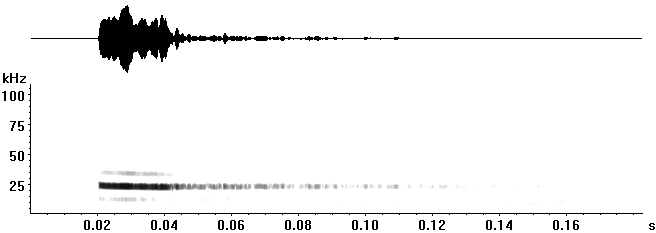







Next-generation ultrasound data acquisition. The breakthrough in mobile and multichannel ultrasound harddisk recording and real-time spectrogram display!
| Avisoft-UltraSoundGate is a complete and easy-to-use USB hardware solution for high-speed harddisk recording. It was specifically designed for recording ultrasound (animal high-frequency vocalizations as bat or cetacean echolocation calls and communication signals by grasshoppers, rodents or other animals). |
Key features
- Portable harddisk recording at sample rates up to 750 kHz with adaptive anti-aliasing filter,
- Avisoft-UltraSoundGate is a turn-key system which comes complete with ultrasound microphone, cables, rugged USB-based data acquisition hardware and recording software (and optional analysis software),
- Direct interfacing to the Avisoft-RECORDER software for real-time spectrogram display(!) with advanced triggering facilities and optionally to the Avisoft-SASLab Pro high-resolution real-time spectrogram display,
- Acoustic real-time (broad-band) monitor,
- Overload indicator & peak level meter,
- When connecting UltraSoundGate to an extra power supply (disconnected from USB), it changes into a self-contained bat detector for acoustic broad-band monitoring.
- Trigger button for quick start and stop of recordings with Avisoft-RECORDER. A digital input line allows to connect external trigger signals (e.g. a remote control button or photo transistor for light-depending trigger enabling). The digital input is sampled and stored at the same rate as the analog input (for acquisition of other custom-specific digital information as serial time-stamp signals (e.g. IRIG-B from a GPS clock) for synchronizing different recording sites),
- Multichannel operation with guaranteed synchronity (Model 416),
- Easy plug-and-play installation,
- Rugged and compact design suited for field use.
| Recording ultrasound has never been easier! |
 USG 116 mith the microphone connected directly |
 USG 116 with microphone extension cable |
 UltraSoundGate 416 |
Specifications |
(Hardware revision 2.0, January 2003) |
| Avisoft-UltraSoundGate model number | USG 116 | USG 112 | USG 416 |
| Sampling rates The maximum possible sample rates are limited by the available USB bandwidth. 500kHz at 16 bit or 750 kHz at 8 bit are only possible if no other high-bandwidth devices are active at the same roots HUB at the same time. Some USB HUBs or USB mouse devices may also require additional bandwidth. USG provides better signal-to-noise ratio's and more precise anti-aliasing performance (32-fold instead of 16-fold oversampling) for the sampling rates marked with #. |
750kHz (8 bit) 500kHz 375kHz # 300kHz 250kHz # 214kHz 187kHz # 166kHz 150kHz # 125kHz 100kHz 75kHz # 62,5kHz # 50kHz # |
300kHz 250kHz # 214kHz 187kHz # 166kHz 150kHz # 125kHz 100kHz 75kHz # 62,5kHz # 50kHz # |
750kHz* 500kHz** + 375kHz** + 300kHz*** + 250kHz**** ++ 214kHz**** ++ 187kHz**** ++ 166kHz**** +++ 150kHz**** +++ 125kHz**** ++++ 100kHz**** ++++ 75kHz**** ++++ 62,5kHz**** ++++ 50kHz**** ++++ * indicates the maximum number of active channels at 8 bit + indicates the number of channels at 16 bit |
| ADC resolutions [bit] |
8 (50 ... 750kHz) 16 (50 ... 500kHz) |
8 (50 ... 300kHz) 12 (50 ... 300kHz) |
8 (50 ... 750kHz) 16 (50 ... 500kHz) |
| ADC type |
sigma-delta with integrated antialiasing filter | ||
| Number of channels (3-pole XLR connector, female) |
1 differential | 4 differential (4 separate AD-converters) |
|
| Acoustic monitor (Avisoft-RECORDER additionally provides for all USG devices a software-based monitor that uses the PC soundcard as output device) |
yes | no | |
| Overload indicator (red LED) | yes | ||
| Peak level meter (4 LEDs) |
yes | no | no |
| Maximum input sensitivity at the XLR input (peak-to-peak full scale) |
+-20 mV | ||
| Gain adjustment potentiometer |
yes (6 ... 30 dB, +30dB by external mic amplifier) | ||
| switchable 5V power supply through XLR pin 3 for external mic amplifier |
yes, max. current 50 mA | ||
| Input impedance |
50 kOhm | ||
| Ultrasound microphone Frequency responses of ultrasound microphones heavily depends on capsule damping. There is a tradeoff between sensitivity and flatness. See also mic types. |
electret type (10...150 kHz) (external and removeabe, other microphones with mic-amp may be used) |
||
| Button for manual triggering with the Avisoft-RECORDER / SASLab Pro software |
yes | ||
| External digital inputs, 2.5mm mini-jack connectors, TTL-compatible (only accessible in 16-bit recording mode) |
1 | - | 4 (one for each analog channel) |
| Frequency response (-3dB, external input without mic) |
1Hz - 370kHz |
1Hz - 145kHz |
1Hz - 370kHz |
| Supply current (drawn from the USB bus 5V supply) |
150 mA |
450 mA |
|
| Body |
handy aluminium enclosure | compact aluminium enclosure | |
| Physical dimensions (W/H/D) in mm | 56 * 35 * 140 | 103 * 56 * 145 | |
| Weight | 300g | 1500g | |
Available accessories
- XLR Microphone extension cable (lengths : 2, 5, 10 or 25 m)
- XLR to RCA adaptor cable
- XLR to BNC adaptor cable
- XLR to 1/4'' phone jack adaptor cable
- XLR to 3.5 mm mini-jack adaptor cable
- External trigger switch fitted with a 2.5 mm mini-jack plug
- External foot trigger switch fitted with a 2.5 mm mini-jack plug
- Rugged 2.5 mm mini-jack plug for self-mounting
- External power supply adapter for stand-alone broad-band bat detector mode
System requirements
- IBM-compatible PC, Pentium, 266MHz or more with at least one USB port, running Windows98, Me, Windows2000 or XP. A Pentium III running at 1 GHz is recommended for the multichannel device USG 416.
Example Recordings
The following recordings were made with Avisoft-UltraSoundGate 116 (sample rate 250kHz) in front of the Avisoft office in Berlin, Germany. For compatibilty to common soundcards, the sampling rate of these files was set to 22.05kHz (time expansion of 1:11).Common pipistrelle (Pipistrellus pipistrellus) echolocation calls
Common pipistrelle approaching an insect (feeding buzz)
Common pipistrelle social call

spectrogram of the social call .wav file created in Avisoft-SASLab Pro
More pipistrelle examples sampled at 214kHz (playback rate 11.025kHz ---> time expansion of 1:20): example4 (152k), example5 (352k), example6 (110k), example7 (239k), example8 (321k), example9 (636k)
Some recordings made during the 12th International Bat Research Conference in Malaysia near the conference venue at the Hotel Equatorial, Bangi (214kHz, playback rate 22.05kHz ---> time expansion of 1:10) : example10, bat (218k), example11, bat (552k), example12, bat (610k), example13, bat (94k), example 14, grasshopper (493k)

The following recordings were made at Bracken Cave, San Antonio, Texas, USA, during the Post Symposium Trip of the Bat Echolocation Symposium organized by Bat Conservation International on 17 April 2002 (originally sampled at 250kHz, resampled down to 220,5kHz and 10-fold time-expanded) : Mexican Free-tailed Bat (688k), Mexican Free-tailed Bat, clutter (173k), Mexican Free-tailed Bat, more clutter (126k).

The song of a bush-cricket (Short-winged conehead, Conocephalus dorsalis) from Berlin-Luebars, Germany (time expansion 1:10).
What are the advantages over common time-expansion devices?
- Real-time spectrogram display during recording,
- Unlimited duration of recordings (only limited by harddisk space),
- No gaps in monitoring (manual transferring of slowed-down sequences onto a tape recorder is not required),
- Simplified analysis because the generated .wav files can be read directly by the sound analysis software (no re-recording of slowed-down tape recordings through soundcard required),
- Automatic frequency-selective triggering for unattended recording,
- Integrated variable anti-aliasing filter,
- Extended dynamic range (resolution of 12 or 16 bit),
- Acoustic broad-band monitor,
- Peak level meter for precise recording level adjustment.
Why USB?
The Universal Serial Bus is a modern and most successful standard for connecting peripherals (printers, scanners, mouse, ...) to PCs. Almost all notebook computers are equipped with USB. That highly standardized interface dramatically simplifies installation of peripherals (plug-and-play). There will be no compatibility problems with interrupts or I/O addresses (which often occur with comparable PCMCIA devices). The required I/O bandwidth for 500kHz sampling is not guaranteed with many PCMCIA or parallel port devices. Only USB meets these requirements safely. The rugged physical connectors are suited very well for field use (in contrast to fragile PCMCIA connectors). For additional channels*, several UltraSoundGate devices can be operated simultaneously through an USB hub.* Channels from different devices are not synchronous.
System Integration
| Avisoft-UltraSoundGate is fully integrated into the sound recording and analysis applications Avisoft-RECORDER and Avisoft-SASLab Pro. |
| Avisoft-RECORDER provides the following key-features in conjunction with UltraSoundGate: |
- Multichannel real-time spectrogram display (0% overlap), waveform envelope display, energy waveform within selected frequency range,
- Pre-tigger harddisk-recording with widely selectable trigger options. Trigger event threshold definition for sound-activated recording can be done graphically by mouse,
- There will be no limitations on the duration of continuous recordings (harddisk space rather than RAM size limits the duration of single recording sessions),
- ASCII-format LOG file containing date, time and duration of each recorded event and optional text comments,
- Manual triggering by the UltraSoundGate button,
- External triggering through the UltraSoundGate digital input (TTL-compatible, 2.5mm mini jack). This external signal can also be used to enable/disable the sound-activated recording mode (e.g. a photo transistor directly connected to the digital input for limiting automatic recording to darkness),
- Multichannel recording with UltraSoundGate 416 with either separate triggering of each channel (separate .wav files for each channel) or simultaneous triggering for all active channels (one single multichannel .wav file containing all channels). The latter configuration is suited for passive acoustic location of animals because all channels are packed into a single data stream, which secures the phase relationship between channels.
- Real-time measurements of call frequencies, that can also be issued by voice messages.
- Real-time acoustic monitoring through the soundcard (heterodyning or aliasing technique).

Avisoft-RECORDER screen shot showing the real-time spectrogram display.

In pre-trigger recording mode, each of the automatically created .wav files contains
one single sound event. A LOG file lists start time and duration of each shot.
| Avisoft-SASLab Pro provides the following key-features in conjunction with UltraSoundGate: |
- Two-channel real-time spectrogram display (0 - 87.5% overlap*and widley adjustable spectrogram parameters) and simultaneous waveform envelope display,
- The UltraSoundGate button can remote control the transfer of the SASLab Pro real-time circular recording buffer into the main window (in order to quickly capture sound events which were recognized graphically or acoustically),
- Two-channel recording with UltraSoundGate 416,
- Real-time element classification (e.g. for species discrimination) and automatic response generation,
- High-quality spectrogram generation (see a multiple-line spectrogram),
- Advanced offline signal analysis and synthesis.

Avisoft-SASLab Pro real-time spectrogram display running at 250 kHz with a FFT size of 256 points and 75% overlap.

Avisoft-SASLab Pro off-line spectrogram display with the Automatic Parameter Measurement facility activated

Numeric results of the Automatic Parameter Measurements shown above
For more details on typical applications see the UltraSoundGate / Avisoft-RECORDER Application Notes and the
 bat-specific leaflet (270k, pdf file format).
bat-specific leaflet (270k, pdf file format).The UltraSoundGate system has been developed by Avisoft Bioacoustics having more than 10 years of experience in designing animal sound analysis software, digital signal processing systems and ultrasound recording / detecting equipment.
Last modified on 17 January 2003, Raimund Specht